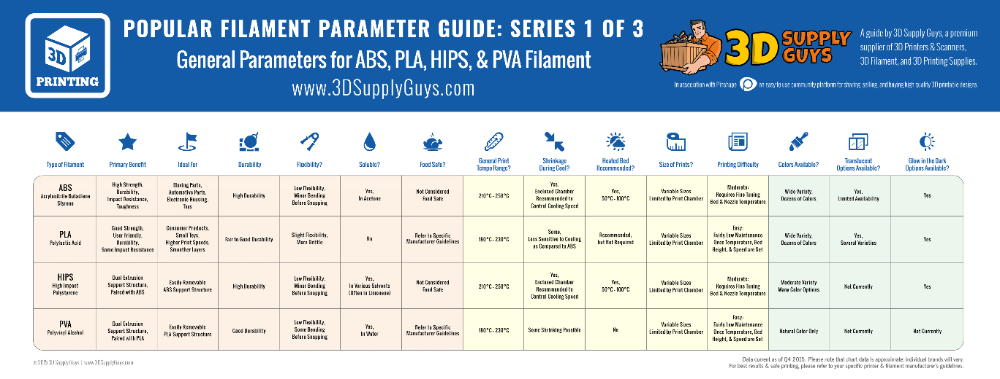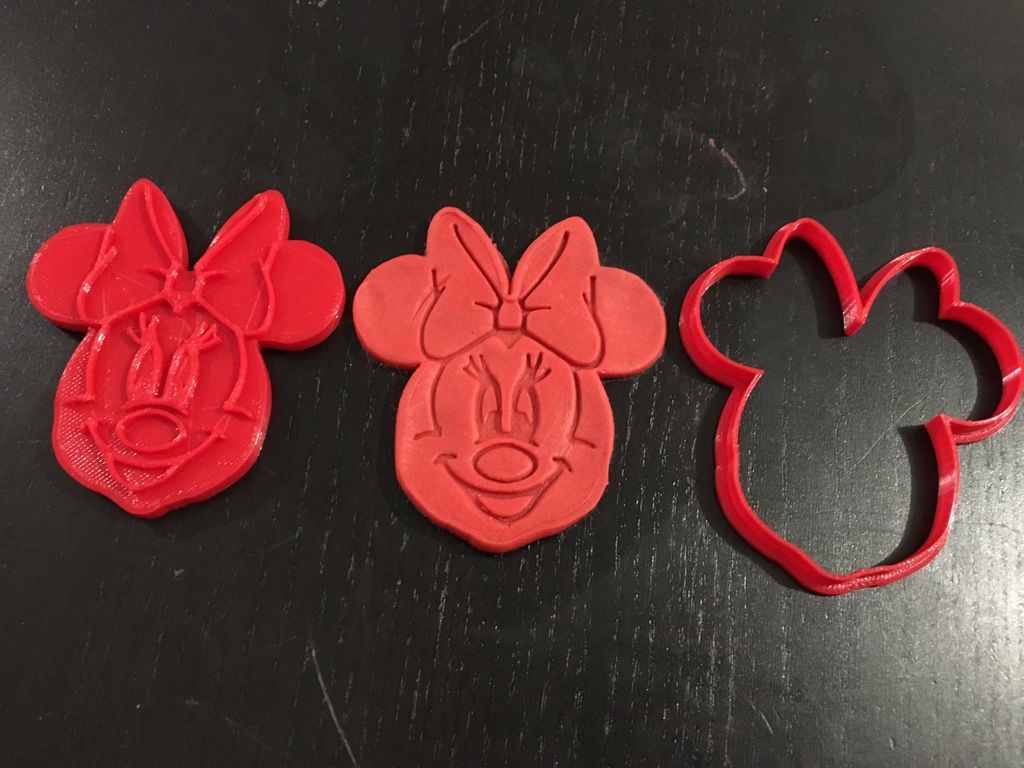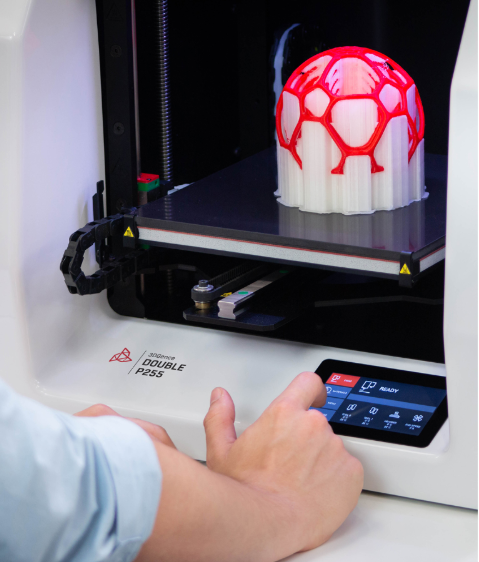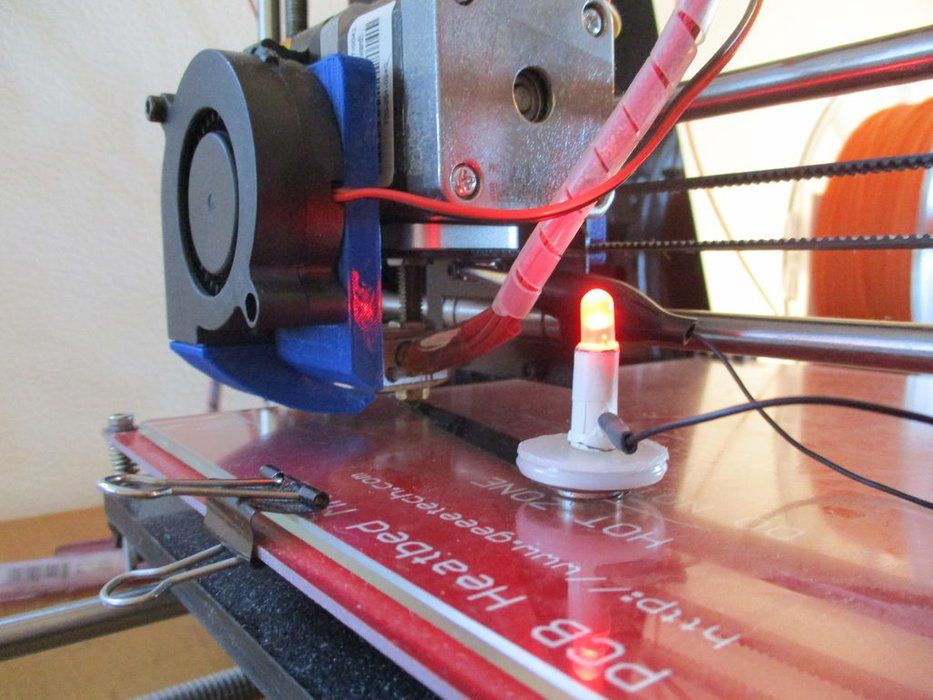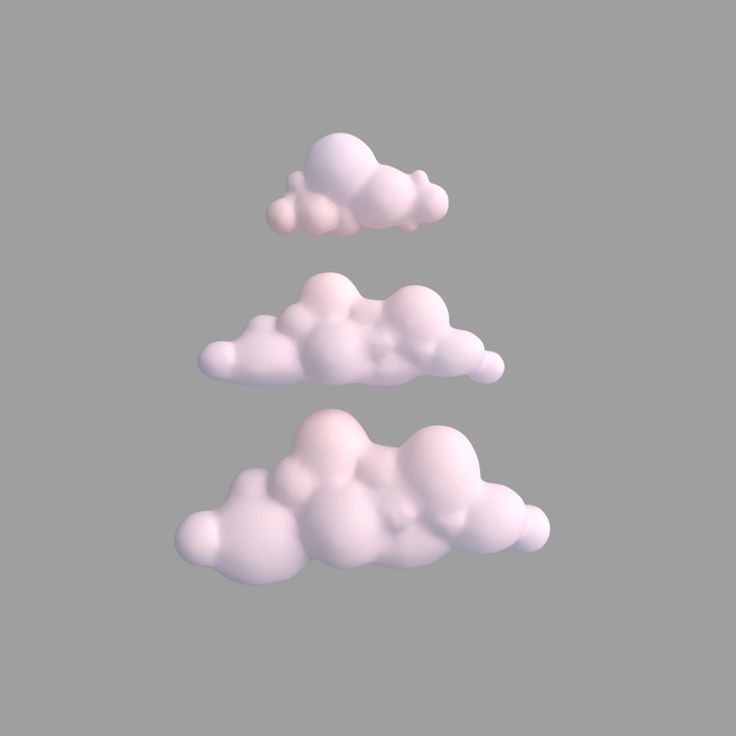Different types of 3d printing filament
What Are the 6 Different 3D Printer Filament Types?
Consumer 3D printers are no longer restricted to ABS and PLA filaments. The popularity of additive manufacturing technology has led to the influx of many engineering plastics. Although ABS and PLA remain popular, many 3D printing enthusiasts have switched to newer materials.
So, here is everything you need to know about different 3D printing filaments and how to choose one for your specific needs.
How to Choose a 3D Printing Filament
3D printing is unlike most run-of-the-mill hobbies. It involves sophisticated robots creating complicated objects using exotic materials. Like all advanced engineering endeavors, 3D printing relies on the users’ ability to read and follow technical data sheets. Knowing how to make sense of these documents is key to knowing which 3D printing filament to use for specific applications.
Image Credit: Nachiket Mhatre There’s no need to bother with this if your 3D printing needs are restricted to cosmetic prints because PLA is all you will ever need. Printing functional parts, however, needs an understanding of various filament parameters, such as tensile strength, toughness/flexibility, heat resistance, durability, creep, and warping.
So, what are the best 3D printing filaments, and when should you use one over another?
1. PLA (Polylactic Acid)
Polylactic Acid is to 3D printing what training wheels are to bicycles. It’s incredibly easy to print on even the cheapest 3D printers. With print temperatures beginning as low as 180°C, you don’t need an all-metal hot end to print this filament safely. PLA doesn’t even require a heated bed, as long as the ambient room temperature is maintained above 20°C.
Image Credits: Nachiket MhatreThe material practically doesn’t warp and can bridge extremely well if you give adequate part cooling. Not sure what all those terms mean? Check out our Ender-3 upgrade guide to learn more about all-metal hot ends and 3D printer safety.
The bottom line: it’s incredibly difficult to ruin a PLA print.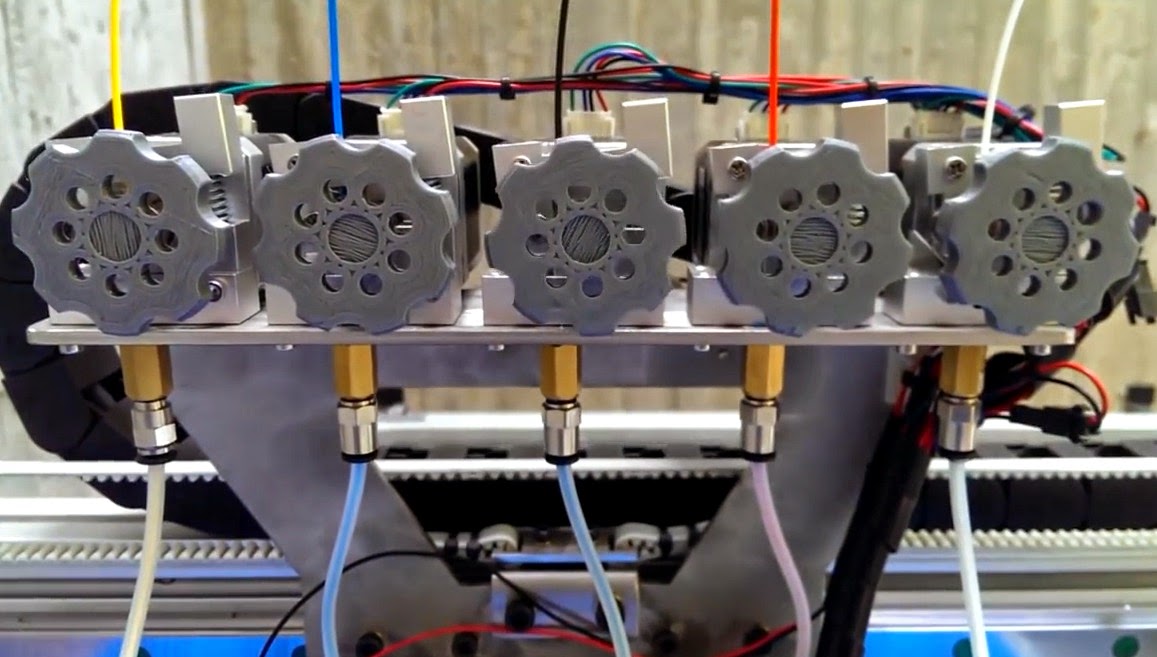 This allows beginners to gradually learn the many complicated aspects of 3D printing without hitting the brick wall of repeated print failures. As a beginner, sticking to PLA makes it easy to grasp the fundamentals of bed adhesion, first layer calibration, overhangs, and bridging. PLA is the optimal way to test the limits of 3D printing without having to second-guess your printer calibration and slicer settings.
This allows beginners to gradually learn the many complicated aspects of 3D printing without hitting the brick wall of repeated print failures. As a beginner, sticking to PLA makes it easy to grasp the fundamentals of bed adhesion, first layer calibration, overhangs, and bridging. PLA is the optimal way to test the limits of 3D printing without having to second-guess your printer calibration and slicer settings.
PLA Filament Properties
- Printability: Excellent
- Color Selection: Excellent
- Heat Resistance: Poor
- Tensile Strength: Excellent
- Toughness: Poor
- UV Resistance: Excellent
- Moisture Resistance: Excellent
- Creep Resistance: Poor
When Should You Use PLA 3D Printing Filament?
PLA is great for cosmetic 3D prints but not so much for anything else.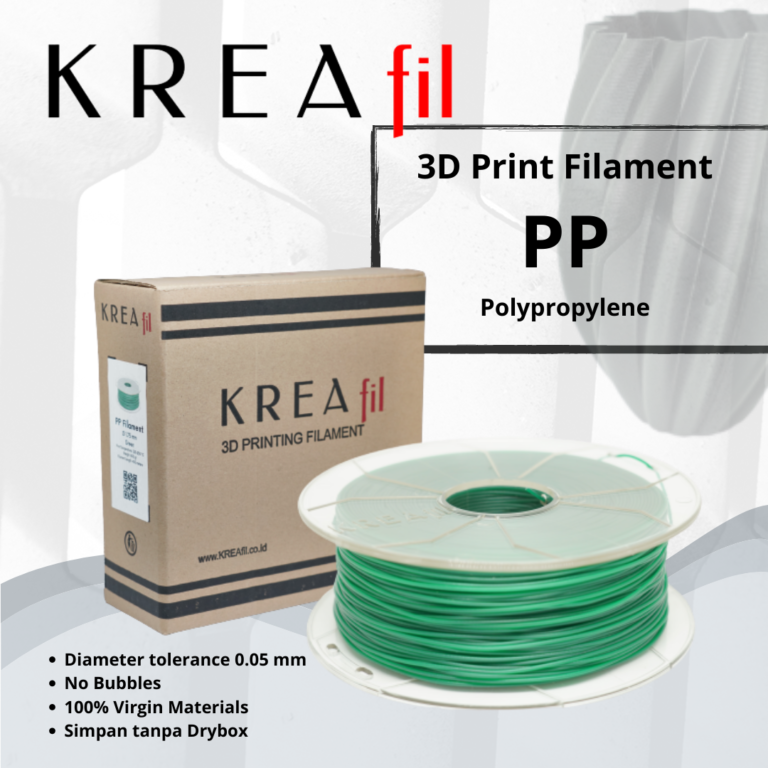 Despite its high tensile strength, it lacks toughness because the material is too hard to flex. This makes it brittle and susceptible to cracking in applications requiring impact resistance and bending. Its low-temperature printability also translates into poor heat resistance. PLA prints warp when subjected to direct sunlight or in-car conditions due to the material’s low glass transition temperature of 57°C.
Despite its high tensile strength, it lacks toughness because the material is too hard to flex. This makes it brittle and susceptible to cracking in applications requiring impact resistance and bending. Its low-temperature printability also translates into poor heat resistance. PLA prints warp when subjected to direct sunlight or in-car conditions due to the material’s low glass transition temperature of 57°C.
PLA’s tendency to creep, or to permanently deform under load at room temperature, makes it unviable for any functional print that either uses fasteners or serves any load-bearing purpose. Consequently, most 3D printing enthusiasts move to other materials once they have mastered slicer settings and 3D printer tuning with PLA.
2. PETG (Polyethylene Terephthalate Glycol)
PETG should ideally be your second filament challenge once you have mastered PLA. It is quite similar to the plastic found in water bottles and food containers, except for the addition of glycol to improve printability. PETG is better than PLA in most important parameters. It’s slightly tougher, significantly more heat resistant, exhibits excellent creep resistance, and is therefore suitable for functional 3D printing.
PETG is better than PLA in most important parameters. It’s slightly tougher, significantly more heat resistant, exhibits excellent creep resistance, and is therefore suitable for functional 3D printing.
However, it is also slightly more difficult to print. That isn’t entirely a bad thing. While it is virtually impossible for a well-tuned printer to mess up PLA prints, getting PETG right requires a better understanding of slicing software and first layer calibration. This makes the filament a safe way to learn these concepts, which are vital to mastering other technically challenging 3D printing filaments.
PETG is also quite hygroscopic, so drying it before printing is necessary if you live in a humid area. The prints themselves aren’t prone to moisture absorption, but a wet filament will cause extrusion and print quality issues. The material can bond permanently to most 3D printing surfaces if the first layer is printed too close to the build surface.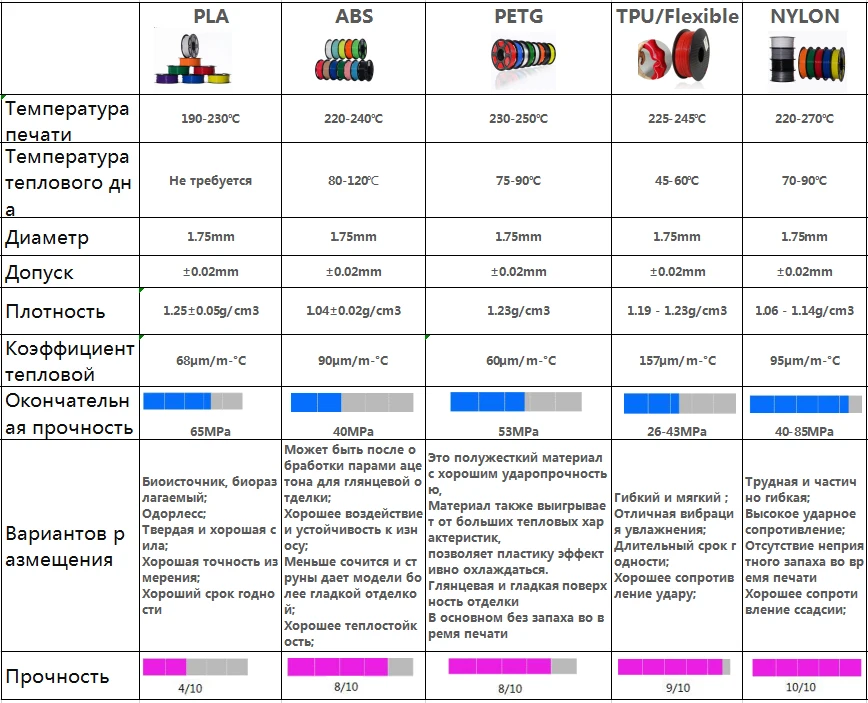
The sticky, viscous nature of the molten filament also makes it a poor choice for bridging and steep overhangs. However, that also translates into the best layer adhesion despite its low printing temperature.
PETG Filament Properties
- Printability: Good
- Color Selection: Good
- Heat Resistance: Average
- Tensile Strength: Good
- Toughness: Good
- UV Resistance: Excellent
- Moisture Resistance: Poor
- Creep Resistance: Good
When Should You Use PETG 3D Printing Filament?
PETG is the perfect compromise between PLA and the much superior ABS filaments. While it lacks the higher temperature resistance of ABS, it is still good enough for prints to be used outdoors or car interiors. It is also considerably tougher than PLA and ideal for applications where impact resistance is desired.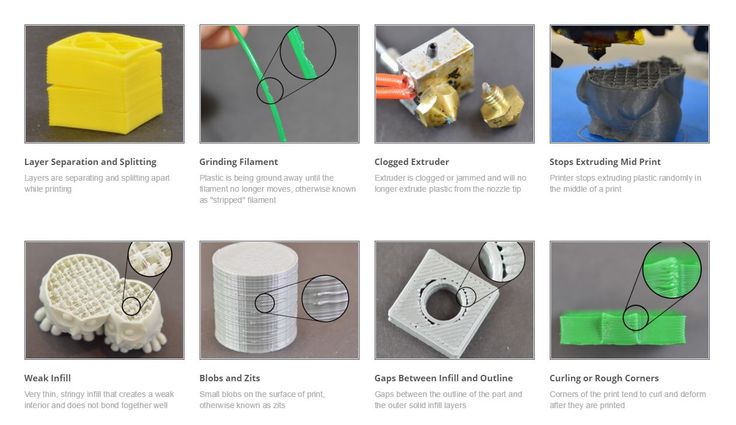 PETG’s resistance to creep also makes it ideal for functional prints and 3D printer components alike.
PETG’s resistance to creep also makes it ideal for functional prints and 3D printer components alike.
3. TPE/TPU/TPC (Thermoplastic Elastomer/Polyurethane/Copolyester)
TPE comprises a number of plastics with rubber-like properties. Such filaments are used in applications where flexibility is desired. Regular flexible filaments marketed as TPE are available in various shore hardness, which is a measure of flexibility. In fact, TPE incorporates a broad category of filaments, including urethane-based TPU, which is slightly more rigid to improve printability. TPC is a copolyester-based variant with improved resistance to heat, UV, and chemical agents.
Printing with TPE and its variants are challenging due to the inherent flexibility of the filament. These filaments are particularly difficult to print with Bowden extruders since the lack of rigidity makes it difficult to push the filament through the nozzle. Therefore, direct drive extruders, with a short filament path between the extruder gears and nozzle, are recommended for reliable printing.
The tendency of the filament to compress and elongate also makes retractions unreliable. This leads to excessive stringing in prints, which requires expertise to mitigate. It is also recommended to print these flexible filaments on an unheated bed, preferably with a release agent, such as a glue stick or hairspray. Failure to do that often results in the prints permanently bonding to the build surface.
TPE Filament Properties
- Printability: Average
- Color Selection: Average
- Heat Resistance: Average
- Tensile Strength: Average
- Toughness: Excellent
- UV Resistance: Good
- Moisture Resistance: Poor
- Creep Resistance: Good
When Should You Use TPE/TPU/TPC 3D Printing Filament?
These flexible filaments are excellent in applications where impact resistance, bendability, wear, and grip are more desirable than rigidity.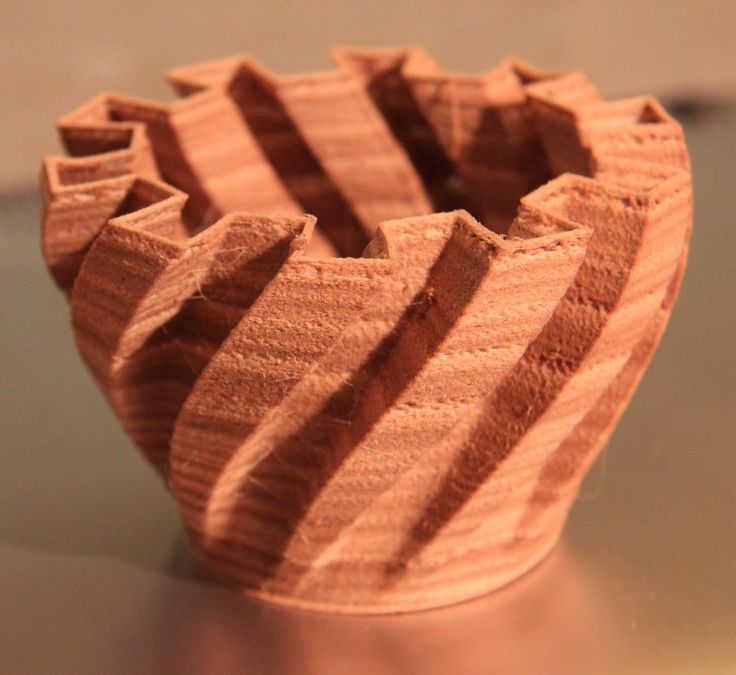 TPE and TPU are regularly used to 3D print gaskets, phone covers, and wristbands for wearable devices. TPC is a more expensive alternative that offers additional temperature and chemical resistance suitable for harsh environments.
TPE and TPU are regularly used to 3D print gaskets, phone covers, and wristbands for wearable devices. TPC is a more expensive alternative that offers additional temperature and chemical resistance suitable for harsh environments.
4. ABS (Acrylonitrile Butadiene Styrene)
ABS, in its injection molded avatar, is found in most consumer products in the form of automobile dashboards and switchgear, toys, pipe fittings, and as the chassis of most consumer durables. Not surprisingly, its familiarity, price, and availability made it the material of choice for the commercial 3D printing industry. It’s a terrific material with an unmatched price-to-performance ratio and good heat resistance.
Image Credit: Nachiket Mhatre Its heat resistance makes it incompatible with the cheap PTFE-lined hot ends. Most ABS filaments require nozzle temperatures of around 250°C. This makes all-metal hot ends mandatory for safe printing. The filament also off-gasses harmful VOCs (volatile organic compounds) such as styrene, which are known to negatively impact health. Learn how ABS compares to PLA in our ABS vs. PLA comparison.
Learn how ABS compares to PLA in our ABS vs. PLA comparison.
ABS filament’s tendency to warp makes it difficult to print unless you own a printer with a heated enclosure, like the Voron series of DIY 3D printers. Delamination, bed adhesion, and warping are persistent issues on large ABS prints on unenclosed printers. Having said that, most modern ABS filament blends print fine, as long as you keep the build volume enclosed and use the heated bed as a passive heat source. Carbon fiber and glass fiber-enhanced ABS composite filaments mitigate these issues to a great extent.
ABS Filament Properties
- Printability: Average
- Color Selection: Average
- Heat Resistance: Good
- Tensile Strength: Good
- Toughness: Good
- UV Resistance: Average
- Moisture Resistance: Good
- Creep Resistance: Excellent
When Should You Use ABS 3D Printing Filament?
ABS exhibits good tensile strength and toughness, which makes it ideal for functional prints and even some engineering applications.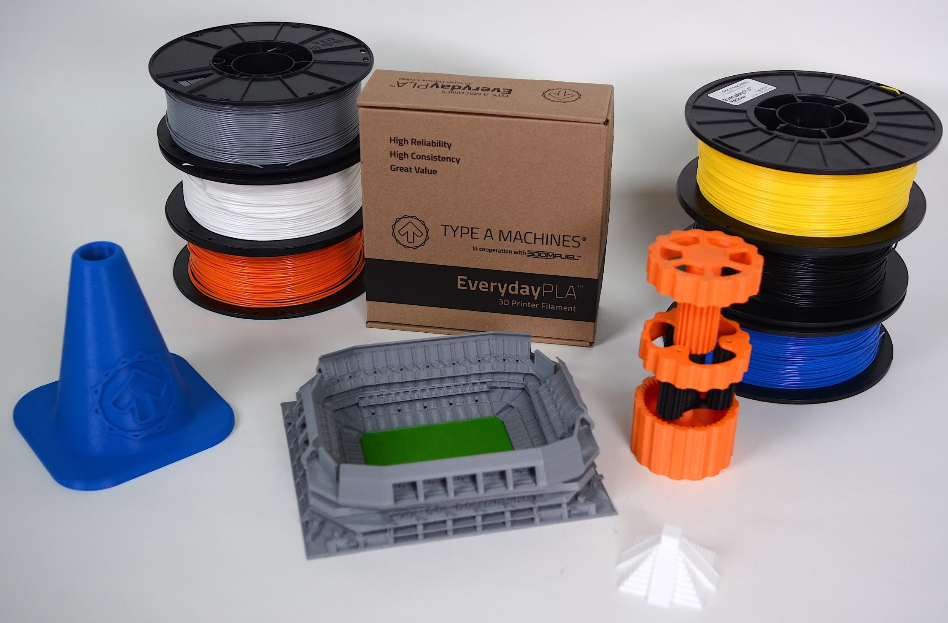 The material can be used in high-temperature applications such as 3D printer hot end components and functional prints for car interiors. Any engineering scenario that demands resistance to heat, impact, and wear can be met cheaply with ABS.
The material can be used in high-temperature applications such as 3D printer hot end components and functional prints for car interiors. Any engineering scenario that demands resistance to heat, impact, and wear can be met cheaply with ABS.
5. ASA (Acrylonitrile Styrene Acrylate)
ASA is a modified form of ABS that is easier to print and exhibits improved UV resistance. Large ASA prints are easier thanks to their tendency to warp less than ABS. Most ASA filaments also tend to off-gas less VOCs while printing.
And all this is achieved while maintaining the strength, toughness, and temperature resistance comparable to ABS. We see no reason to choose ABS if you can afford the slight premium commanded by ASA filaments.
ASA Filament Properties
- Printability: Good
- Color Selection: Average
- Heat Resistance: Good
- Tensile Strength: Good
- Toughness: Good
- UV Resistance: Excellent
- Moisture Resistance: Good
- Creep Resistance: Excellent
When Should You Use ASA 3D Printing Filament?
ASA can be used for the same applications as ABS, with the added versatility of maintaining durability and color integrity despite heavy exposure to sunlight.
6. PA (Polyamide or Nylon)
Polyamide, better known as its brand name Nylon, is found in consumer durables in the form of gears, hinges, and sliding components—basically in any application that calls for extreme wear resistance, low friction, excellent toughness, and some degree of temperature tolerance. PA is indispensable in powder-sintered 3D printing processes employed in commercial SLS 3D printers.
Image Credit: Nachiket MhatreNylon also exists in the FDM 3D printing space in various blends offering different compromises between heat resistance, toughness, durability, and creep resistance. The latter is important because the material exhibits a tendency to heat creep in its natural state. Therefore, most engineering applications require PA blended with carbon or glass fiber to improve tensile strength, creep resistance, and temperature tolerance.
The material’s high glass transition temperature and an innate tendency to warp make it difficult to print on cheap, unenclosed printers. Furthermore, PA’s chronic tendency to absorb moisture requires filament dryers that can reliably maintain 80°C chamber temperatures. In fact, successful printing also requires the filament to be routed through a dry box while printing. It’s a great engineering filament that demands a capable printer and an experienced operator.
PA Filament Properties
- Printability: Poor
- Color Selection: Poor
- Heat Resistance: Good
- Tensile Strength: Good
- Toughness: Excellent
- UV Resistance: Average
- Moisture Resistance: Poor
- Creep Resistance: Average
When Should You Use PA 3D Printing Filament?
Functional PA prints work well as mechanical parts, such as gears, hinges, and levers. The material is also tough enough to be used to manufacture custom tools and prototypes requiring strong meshing parts subjected to friction and impact. Various glass fiber and carbon fiber blends can also be used to modify the rigidity and flexibility of the material to suit different engineering demands.
6. PC (Polycarbonate)
PC is one of the strongest 3D printing filaments accessible to consumer 3D printers. How strong, you ask? Well, the material is used to manufacture everything from bullet-proof glass to fighter jet canopies. PC can withstand temperatures as high as 110°C, with some blends even outperforming that impressive figure.
PC has the unique distinction of exhibiting high tensile strength while also being extremely impact resistant. This gives it the distinction of excelling in applications where even Nylon falls short. However, these physical properties make PC challenging to print. It isn’t uncommon for some PC blends to require nozzle temperatures of 300 °C, with the heated bed maintained in excess of 100 °C.
The material is also prone to excessive warping and only adheres well to polycarbonate build surfaces or polyimide tape. However, like Nylon, PC is available in various blends, making it more printable.
PC Filament Properties
- Printability: Poor
- Color Selection: Poor
- Heat Resistance: Excellent
- Tensile Strength: Excellent
- Toughness: Excellent
- UV Resistance: Excellent
- Moisture Resistance: Poor
- Creep Resistance: Excellent
When Should You Use PC 3D Printing Filament?
PC is employed in various industrial, automotive, and electrical applications—especially those requiring high strength and temperature resistance. The inherent optical clarity of the material also makes it ideal for transparent prints, as long as the wall thickness is kept minimal.
Choose Your 3D Printing Filament Wisely
Now that you have a handy means to compare various physical properties and performance parameters of consumer-grade filaments, choosing the right one is a matter of evaluating which parameters are best suited to your particular applications.
If you are new to 3D printing, we recommend starting with PLA and graduating to PETG before taking on more challenging materials such as ABS and Nylon.
Types of 3D Printer Filaments
FDM (Fused deposition modeling) 3D printers make use of filaments. These materials are supplied on a 3D printer spool and are directed through a heated nozzle by means of an extruder. The extruded plastic is then used to build up a 3D printed part, layer by layer. There are different 3D printer filament types. However, 10 of the most commonly used will be described in this article including their mechanical properties, characteristics, advantages, and disadvantages.
1. PLA Filament
Polylactic acid (PLA) is a thermoplastic monomer made from organic sources. This is in contrast to other 3D printer filament types that are made from petroleum products. PLA is easy to print and is environmentally friendly. However, it is brittle and has poor UV resistance. Additional key characteristics are:
- Warping: PLA does not warp easily during printing
- Solubility: PLA is not soluble in water.
But, it can be dissolved in acetone, methyl ethyl ketone, or caustic soda.
- Food Safety: PLA is food safe
Table 1 lists the mechanical properties of PLA:
Table 1. PLA Mechanical Properties
Tensile Strength | 65 MPa |
Flexural Modulus | 3.8 GPa |
Print Temperature | 130 to 180 °C |
Print Bed Temperature | 50 °C |
Some types of PLA filament can be conductive, for more information see our full guide on Conductive PLA Filaments for 3D Printing.
2. ABS Filament
Acrylonitrile Butadiene Styrene (ABS) is a widely used engineering plastic and 3D printing filament type. ABS exhibits excellent toughness and can withstand relatively high temperatures. Printing with ABS requires high temperatures for both the hot end and the printer bed. Heated build volumes are also required for good results. Additionally, all types of ABS tend to warp during printing, which results in poor dimensional accuracy. Additional key characteristics are:
- Durability: ABS has excellent resistance to overall wear and tear. It is both tough and impact resistant.
- Solubility: ABS is not soluble in water. However organic solvents like acetone, methyl ethyl ketone, and esters will dissolve ABS.
- Food Safety: ABS is a food-grade plastic
Table 2 lists the mechanical properties of ABS:
Table 2. ABS Mechanical Properties
Tensile Strength | 40 MPa |
Flexural Modulus | 1.6 to 2.4 GPa |
Print Temperature | 220 to 250 °C |
Print Bed Temperature | 95 to 110 °C |
For more information see our full guide on ABS 3D Printer Filament.
3. Carbon Fiber Filament
3D printer filaments can be made with specific additives to either improve their mechanical properties or aesthetic appearance. Typical 3D printing filament types used include PLA, PETG, or ABS. For the purpose of comparison, ABS-filled 3D printer plastic will be used.
Carbon-fiber-filled filaments have improved mechanical properties when compared to unfilled thermoplastics. They also have good dimensional stability. Carbon fiber filaments are brittle and clog easily. Listed below are additional key characteristics:
- Durability: The addition of carbon fiber improves the durability of ABS
- Warping: The addition of carbon fiber reduces the amount of warping that is common with unfilled ABS
- Solubility: Carbon-fiber-filled ABS is soluble in organic solvents like acetone, methyl ethyl ketone, and esters.
Table 3 lists the mechanical properties of Carbon fiber filament:
Table 3. Carbon Fiber Mechanical Properties
Tensile Strength | 46 MPa |
Flexural Modulus | 5.26 GPa |
Print Temperature | 220 to 240 °C |
Print Bed Temperature | 100 to 110 °C |
4. Nylon Filament
Nylon or polyamide is a widely used engineering thermoplastic due to its excellent wear resistance and durability. The most commonly used grade of nylon for 3D printer filaments is PA 6. Nylon is both impact and wear-resistant. However, nylon tends to absorb moisture easily. It also requires relatively high print temperatures of up to 265 °C. Below is a list of nylon’s other key characteristics:
- Warping: Due to the high temperatures involved, nylon tends to warp during printing. As such, a heated enclosure is recommended.
- Solubility: Nylon expands when exposed to water due to its hygroscopic nature. Acetic acid and formic acid will dissolve nylon.
- Food Safety: There are grades of nylon that are food safe
Table 4 lists the mechanical properties of nylon:
Table 4. Nylon Mechanical Properties
Tensile Strength | 40 to 85 MPa |
Flexural Modulus | 0.8 to 2 GPa |
Print Temperature | 225 to 265 °C |
Print Bed Temperature | 70 to 90 °C |
For more information see our full guide on Nylon 3D Printer Filament.
5. FLEX Filament
FLEX filament is a proprietary blend of polymers that creates a flexible copolymer 3D printing filament type. Flex is part of the TPU (thermoplastic polyurethane) family of materials. Parts printed with this material can achieve a shore A hardness of 93 A. They are also flexible and impact resistant. Parts printed using flex are hygroscopic. This means that it should be dried before use and kept dry during long prints. Other key characteristics are:
- Durability: Flexible materials are by their nature durable; this is no different with FLEX filaments
- Warping: No warping
Table 5 lists the mechanical properties of FLEX filament:
Table 5. FLEX Mechanical Properties
Tensile Strength | 40 MPa |
100% Modulus | 9.5 MPa |
Hardness | 93 Shore A |
Elongation at Break | 500% |
Print Temperature | 210 to 230 °C |
Print Bed Temperature | 60 °C |
For more information see our full guide on Flex 3D Printer Filament.
6. HIPS Filament
High impact polystyrene (HIPS) is a thermoplastic often used for pre-production machining prototypes. However, it is also one of two 3D printing filament types used as a soluble support material, alongside ABS. HIPS has similar properties to ABS, making it an ideal second extruder material. Despite being soluble, HIPS produces harmful fumes during printing. As such, it is recommended to print in a well-ventilated area or to direct fumes outside with a duct. Other key characteristics are:
- Durability: HIPS has excellent durability due to its unique mix of flexibility and strength
- Warping: HIPS can suffer from excessive warping if temperatures are not carefully controlled. Heated enclosures are recommended.
- Solubility: HIPS is soluble in D-limonene
- Food Safety: HIPS is a food-safe material
Table 6 lists the mechanical properties of HIPS:
Table 6. HIPS Mechanical Properties
Tensile Strength | 32 MPa |
Flexural Modulus | 1.5 to 3 GPa |
Print Temperature | 230 to 245 °C |
Print Bed Temperature | 100 to 115 °C |
7. PVA Filament
Polyvinyl alcohol is a biodegradable 3D printer plastic that dissolves easily in water. It also has printing properties close to that of PLA. This makes PVA one of the more ideal 3D printing filament types for PLA support material. Although PVA is easy to use, it can be expensive due to it being used as a sacrificial support material. Some key characteristics of PVA are listed below:
- Durability: Due to its water solubility, PVA is not useful in most applications, as moisture will degrade the plastic
- Warping: PVA can warp to some degree
- Food Safety: PVA will dissolve in the presence of water; as such it is not recommended for use with food
Table 7 lists the mechanical properties of PVA:
Table 7. PVA Mechanical Properties
Tensile Strength | 78 MPa |
Flexural Modulus | N/A |
Print Temperature | 185 to 200 °C |
Print Bed Temperature | 45 to 60 °C |
For more information, see our full guide on PVA 3D Printer Filament.
8. PETG Filament
Polyethylene terephthalate glycol-modified (PETG) is a modified variant of PET. The addition of glycol lowers the melting temperature sufficiently for PETG to be more user-friendly. Aside from being easy to print, PETG is also UV-resistant. Its key disadvantages are its poor adhesion and its tendency to create strings when the printhead crosses empty space between features. Other key characteristics of PETG are:
- Durability: PETG has excellent mechanical properties, while also being resistant to a wide range of chemicals and high temperatures
- Warping: PETG is not particularly prone to warping
- Solubility: PETG is soluble in toluene and methyl ethyl ketone (MEK)
- Food Safety: PET is food safe and by extension so is PETG
Table 8 lists the mechanical properties of PETG :
Table 8. PETG Mechanical Properties
Tensile Strength | 53 MPa |
Flexural Modulus | 2.2 GPa |
Print Temperature | 230 to 250 °C |
Print Bed Temperature | 75 to 90 °C |
For more information see our full guide on PETG 3D Printer Filament.
9. TPE Filament
Thermoplastic elastomers are flexible materials that can be melt-processed in most types of 3D printers. There are many 3D printing filament types of TPE, and it is easy to confuse TPE with TPU. TPU is generally on the harder shore A range whereas TPE is softer. The properties and characteristics described in this section are based on the FilaFlex TPE filament. FilaFlex has high elasticity and good bondability. It is expensive, however. Some key characteristics of TPE are:
- Durability: TPE has good abrasion resistance and excellent flexibility
- Warping: TPE does not warp
- Food Safety: TPE is not food safe
Table 9 lists the mechanical properties of TPE:
Table 9. TPE Mechanical Properties
Tensile Strength | 32 MPa |
100% Modulus | 3.6 MPa |
Hardness | 70 A |
Elongation at Break | 900% |
10. PC Filament
Polycarbonate (PC) is an advanced engineering thermoplastic with excellent mechanical properties and is the strongest 3D printer filament. It has high strength and a glass transition temperature of 150 °C, making it ideal for high-temperature applications. However, PC needs to be printed at very high temperatures of up to 310 °C. It is very hygroscopic and will readily absorb moisture. This moisture can then cause defects in the printed part. Other key characteristics of PC are:
- Durability: PC is one of the most durable 3D printing filament types
- Warping: PC is very prone to warping
- Solubility: PC can be dissolved in tetrachloromethane, pyridine, and chloroform
- Food Safety: PC can be used for food containers
Table 10 lists the mechanical properties of PC:
Table 10. PC Mechanical Properties
Tensile Strength | 72 MPa |
Flexural Modulus | 2.2 to 2.5 GPa |
Print Temperature | 260 to 310 °C |
Print Bed Temperature | 80 to 120 °C |
How to Choose the Best Type of Filaments?
Selecting the best 3D printer filament depends on the application. If a quick prototype is required then PLA will suffice. However, if more strength is required ABS might be a better choice. It is also ideal to choose a material that doesn't warp readily and does not absorb moisture. Eliminating these two common problem areas will make the print easier. For more information, see our guide on printing in 3D.
Which Filament Produces the Smoothest Prints?
PETG is one of the 3D printing filament types that produces very smooth prints provided the printer is properly calibrated. However, printing in ABS and then smoothing with acetone can also create very smooth parts.
What Is the Strongest 3D Printer Filament?
Polycarbonate is the strongest 3D printer filament, provided it is printed correctly.
What Is the Best Filament To use?
For general purpose use, PETG is an excellent option as it is cheap, easy to print, and has good mechanical properties.
What Is the Best Filament for Beginners?
PLA is a good filament for beginners as it is cheap, is often shipped with new printers, and is very easy to get up and running.
What Are the Differences Between ABS and PLA Filaments?
Both PLA and ABS are widely used types of 3D printer filament. For more information, see our guide on PLA vs ABS – What's The Difference?
Table 11 shows the comparison between the two:
Table 11. PLA vs. ABS Comparison
| Property | PLA | ABS |
|---|---|---|
Property Tensile Strength | PLA 65 MPa | ABS 40 MPa |
Property Stiffness | PLA 3. | ABS 1.6 to 2.4 GPa |
Property Glass Transition Temperature | PLA 50 to 80 °C | ABS 105 °C |
Property Ease of printing | PLA Essentially plug-and-play | ABS Requires high temperatures, tends to warp, and requires a heated build volume |
Property Chemical resistance | PLA Good chemical resistance | ABS Good chemical resistance |
Property Durability | PLA PLA is brittle and cracks easily. PLA cannot withstand long-term outdoor exposure | ABS ABS is very durable, with high impact resistance and good wear resistance |
In terms of a functional material for real-world applications, ABS is the better material.
Summary
This article reviewed 10 of the most common 3D printer filaments and presented their mechanical properties, characteristics, advantages, and disadvantages. To learn more about 3D printer filament types and uses and how Xometry can assist with 3D printed parts, contact a Xometry representative.
Xometry offers a full range of 3D printing services for your project needs. Visit our Instant Quote Engine to get a free, no-obligation quote in minutes.
Disclaimer
The content appearing on this webpage is for informational purposes only. Xometry makes no representation or warranty of any kind, be it expressed or implied, as to the accuracy, completeness, or validity of the information. Any performance parameters, geometric tolerances, specific design features, quality and types of materials, or processes should not be inferred to represent what will be delivered by third-party suppliers or manufacturers through Xometry’s network. Buyers seeking quotes for parts are responsible for defining the specific requirements for those parts. Please refer to our terms and conditions for more information.
Team Xometry
This article was written by various Xometry contributors. Xometry is a leading resource on manufacturing with CNC machining, sheet metal fabrication, 3D printing, injection molding, urethane casting, and more.
What is the best plastic for 3D printing? Let's figure it out together!
Plastic for 3D printing
After purchasing your own FDM 3D printer, as well as in the course of choosing it, it becomes necessary to choose the right plastic for 3D printing. But how to do this if you are new to 3D printing and have little to no understanding of this issue? Plastic for printing on a 3D printer is in most cases the main component of successful product reproduction. Therefore, we will not save on knowledge, and will tell you how to choose the best plastic for 3D printing.
Types of plastic for a 3D printer
First of all, we need to consider the types of plastic for a 3D printer. Plastic for 3D printing, or filament, is produced in the form of a thin thread with a diameter of 1.75 mm and 3 mm. Most often, filaments with a thickness of 1. 75 mm are used in the basic configuration, but some manufacturers of 3D printers provide the ability to install a 3 mm plastic feed system. Plastic for 3D printing has many varieties, among which the most common are ABS and PLA plastic.
Plastic for 3D printing: varieties
By popularity in the Ukrainian market, the following types of plastic for 3D printing can be distinguished:
- PLA (PLA) or polylactide. Organic and short lived. Suitable for 3D printing of decorative products, but not able to withstand high mechanical loads;
- ABS (ABS) or acrylonitrile butadiene styrene. It has a long life and excellent mechanical properties. Heat-resistant and used for industrial purposes. Shrinks on cooling. It is recommended to print in ventilated areas;
- PVA (PVA) or polyvinyl alcohol. A water-soluble material that is used as a support;
- Nylone (Nylon). An alternative to ABS plastic, suitable for many engineering structures. When printing with nylon, it is recommended to ventilate the room;
- HIPS (High Impact Polystyrene).
In terms of physical properties, it is a cross between PLA and ABS. May also emit toxic fumes when printed.
Other questions and answers about 3D printers and 3D printing:
What is the best plastic for a 3D printer?
In fact, there are many more types of plastic for 3D printing. This can include flexible, fluorescent and luminescent filament, wood and metallized materials. But in practice, such consumables are rarely used and are needed for narrowly specific purposes. Metallized plastics are interesting in their own right, but they are at the initial stage of development and are inferior in performance to ordinary reinforced materials. “And what plastic is best for a 3D printer?” - you ask. You should choose based on specific goals. If you intend to print decorative elements that will not be subject to payload, you can look at PLA plastic. If your goal is to print gears, structural parts and other things, look at reinforced materials for 3D printing.
What plastic to print with?
Please note that not every printer supports the full range of 3D printing materials. Before buying a specific filament, check the specifications of your own device to avoid wasting money. The rest is up to you and your imagination. A huge range of colors and shades of plastic is available for sale, matte and glossy, semi- and fully transparent materials. Such a variety will allow you to make almost any product to your taste.
Remember that if you need to buy plastic for 3D printing - 3DDevice store is at your service! We offer a wide range of different materials in all possible color options and are ready to provide advice when choosing a filament.
If you have additional questions that we have not covered, write to us by e-mail and we, if necessary, will add your questions! Best regards, 3DDevice team. We also provide 3D modeling, 3D scanning and 3D printing services. We work all over Ukraine! If you have any questions, please contact us in any way convenient for you. Contacts are listed here. We look forward to collaborating!
The choice of plastic for a 3D printer is very important, especially when the goal is to print a functional model with certain properties. It will be a shame if the printed gear breaks almost immediately, or the decorative model quickly loses its beauty.
It is important to understand whether the printer will be able to work with the selected plastic. Some materials (most often engineering) require certain conditions for successful printing.
First, decide which model you want to print. What properties should it have? Does the model need to be durable? Or is it a master model for further replication, in which the quality of the surface is important?
90% of 3D printers use 1.75 diameter filament. 3mm diameter is rare, but it is better to check in advance which size is used in your printer.
PLA
PLA (Polylactide) is the most popular and affordable 3D printer plastic. PLA is made from sugar cane, corn, or other natural raw materials. Therefore, it is considered a non-toxic, biodegradable material.
Extruder temperature - 190-220 degrees. Table heating is not needed, but if the printer's table has a "heater" for better adhesion, you can heat it up to 50-60 degrees. PLA is very easy to work with. The only requirement is to blow the model. There is practically no shrinkage in this material. When printed, it is practically odorless, and if it smells, it smells like burnt caramel.
Pros:
-
Does not shrink. This makes it easy to build prefabricated or huge models without changing dimensions.
-
There are no specific requirements for a 3D printer. Any working 3D printer will do. PLA doesn't need a heated table or a closed case.
-
Non-toxic. Due to this, during printing it does not smell or has a barely perceptible aroma of burnt caramel.
-
Diverse color palette.
Cons:
-
PLA is poorly sanded and machined.
-
It begins to deform already with a slight heating (about 50 degrees).
-
Fragility. Compared to other materials, PLA is very brittle and breaks easily.
-
Decomposes under the influence of ultraviolet radiation. Of course, it will not fall apart into dust, but it can become more brittle and fade.
PLA is perfect for making dimensional or composite models. For example, decorative interior items, prototyping, electronics cases, etc.
Recently, PLA+ has appeared on the market. It may differ from conventional PLA in improved performance. For example, more durable, with improved layer adhesion.
Dummy turbine
Decorative coasters
ABS
ABS (acrylonitrile butadiene styrene) is the second most popular plastic for 3D printing due to its properties, availability and low price.
Extruder temperature - 220-240 degrees. The temperature of the table is 80-100 degrees. For printing, a heated table is required at the printer. It is desirable to have a closed chamber, because ABS "does not like" drafts. Due to a sharp temperature drop, it can “unstick” from the table or crack in layers. ABS can smell bad when printing, so it is recommended to use the printer with a closed chamber and filters, or print in a well-ventilated area.
Pros:
-
Good strength characteristics allow the production of functional prototypes from ABS.
-
Simple mechanical and chemical processing. ABS is easy to sand and drill, and with an acetone bath you can achieve a perfectly smooth surface.
-
It is currently the most inexpensive type of plastic for 3D printing.
-
Large selection of colors and shades.
Cons:
-
High shrinkage. Because of this, it can be problematic to manufacture overall products.
-
Printing requires a heated bed and a closed chamber.
Without this, the ABS may peel off the table or crack in layers.
-
During the printing process, ABS can smell bad. Therefore, it is recommended that you print in a ventilated area or use the printer with a sealed chamber and filter.
ABS is an engineering plastic. It is suitable for the manufacture of simple functional products.
ABS after chemical treatment in an acetone bath
RU model in ABS
ABS+ differs from conventional ABS in improved strength characteristics (elasticity, rigidity, hardness), less shrinkage and sometimes resistance to certain oils and solvents (eg gasoline).
HIPS
HIPS (high impact polystyrene) - originally conceived as a soluble support plastic for materials with high printing temperatures. For example for ABS or Nylon.
The extruder temperature is 230-260 degrees. The temperature of the table is 80-100 degrees. It is desirable to have a closed camera for a 3D printer.
Pros:
-
Less shrinkage than ABS.
-
Ease of machining.
-
The matte surface looks very advantageous on decorative products.
-
Food contact allowed (but be sure to check with a specific manufacturer for certificates)
Cons:
-
For printing, you need a printer with a heated table and a closed chamber.
-
More flexible and less durable than ABS. Because of this, it will not be possible to produce functional products.
-
Small palette of colors.
Most often, HIPS is used for its intended purpose for printing on 2x extruder printers as a support for ABS. It dissolves perfectly (though not very quickly) in limonel.
Sometimes HIPS is used as an independent material. Products from it are not very durable, but this plastic is loved for easy post-processing. HIPS can be used for models that will subsequently come into contact with food (not hot).
Using HIPS as a Soluble Support
Decorative vase made of HIPS
PVA
PVA (polyvinyl alcohol) is a material that was developed as a water soluble support for PLA.
Extruder temperature - 190-210. Table heating is not required. PVA is a slightly "capricious" material, it is not recommended to overheat it and print at high speeds.
PVA is very hygroscopic and dissolves in plain water. Therefore, it is only used as a support for PLA or other plastics with print temperatures close to PVA.
Soluble PVA Support
Add to compare
Item added to compare Go
| Manufacturer | Tiger3D |
Add to compare
Product added to compare Go
| Manufacturer | Tiger3D |
Add to compare
Product added to compare Go
| Manufacturer | Esun
Add to compare
Product added to compare Go
| Manufacturer | Esun
PETG
PETG (polyethylene terephthalate) combines the best properties of PLA and ABS. It is easy to work with, it has a low percentage of shrinkage and excellent sintering of the layers.
Extruder temperature - 220-240 degrees. Table temperature - 80-100 degrees. During the printing process, the model must be well blown.
Pros:
-
Excellent sinterability of layers.
-
PETG is very strong and wear resistant. Good impact resistance.
-
Virtually no smell when printing.
-
Non-toxic.
-
Little shrinkage.
Cons:
PETG is perfect for printing functional models. Due to its low shrinkage, it is often used to make large or composite models. Due to its low toxicity, PETG is often used for products that will come into contact with food.
Cookie cutters and patterned rolling pin
SBS
It is a highly transparent material. At the same time, it is durable and resilient. SBS is a low toxicity plastic. It can be used to print food contact models.
Extruder temperature - 230 -260 degrees. Table temperature - 60-100 degrees. You can print without the closed case on the printer.
Pros:
-
slight shrinkage
-
Transparency. After treatment with solvent, limonel or dichloromethane, beautiful transparent products with an almost smooth surface can be obtained.
-
Easily processed mechanically or chemically.
-
Allowed contact with food.
Cons:
SBS is excellent for translucent vases, children's toys and food containers. Or functional things that require transparency, such as custom turn signals for a motorcycle or car, lamps or bottle prototypes.
Vases are perfectly printed with a thick nozzle (0.7-0.8) in one pass (printing in 1 wall or spiral printing in a slicer).
![]()
Models of bottles after chemical treatment
Nylon
Nylon (polyamide) is considered the most durable material available for home 3D printing. In addition to good abrasion resistance and strength, it has a high slip coefficient.
Extruder temperature - 240-260 degrees. The temperature of the table is 80-100 degrees. Nylon is a very capricious and hygroscopic material - it is recommended to dry the coil with plastic before use. For printing, you need a printer with a heated table and a closed chamber, without this it will be difficult to print something larger than a small gear.
Pros:
-
High strength and wear resistance.
-
High slip factor.
-
Heat resistance compared to other 3D printing plastics.
-
High resistance to many solvents.
-
Good for mechanical processing.
Perfectly polished and drilled.
Cons:
Nylon is perfect for making wear-resistant parts - gears, functional models, etc. Sometimes nylon is used to print bushings.
Nylon gear
Add to compare
Product added to compare Go
| Manufacturer | Tiger3D |
Add to compare
Product added to compare Go
| Manufacturer | Tiger3D |
Add to compare
Product added to compare Go
| Manufacturer | Esun
Add to compare
Product added to compare Go
| Manufacturer | Bestfilament |
Soft plastics
FLEX (TPU, TPE, TPC) is a material similar to silicone or rubber. It is flexible and elastic, but at the same time tear-resistant. For example, TPE is a rubbery plastic, while TPU is more rigid.
FLEX are printed at a temperature of 200-240 (depending on the material). A heated table is not required. On printers with direct material feed (feed mechanism on the print head), there are usually no problems with printing. On a bowden feeder (the feed mechanism is located on the body), printing with very soft plastics can be difficult. Usually it is necessary to additionally adjust the clamping of the bar. The main nuance is the very low print speeds - 20-40mm.
Pros:
Cons:
Depending on the type of FLEXa, the models can be flexible or rubber-like. This material, depending on its softness, can be used to print gaskets, insoles, belts, tracks or other models that require flexibility or softness.
FLEX belt
Trainers with flexible soles
Wheel for switchgear model
Decorative plastics
Decorative plastics are PLA plastics with various fillers (wood or metal shavings). Or with dyes selected to imitate different materials. Since the base of the plastic is PLA, it is very easy to print.
Extruder temperature - 200-220 degrees (depending on the manufacturer). A heated table is not required.
Pros:
Cons:
-
Some fillers (eg clay) are abrasive. For such plastics, the standard brass nozzle cannot be used. Will have to buy a harder steel nozzle.
-
Some decorative plastics can clog the small nozzle (0.4 or less). For them, you need to use a “thicker” nozzle.
Depending on the filler, different material properties are obtained. Plastics that use only dye do not require additional processing. Materials with "fillers" may sometimes require additional post-processing.
Plastics with metal fillers after printing must be processed with a metal brush. Then the Metal content will show through and the model will resemble a metal casting.![]()
Plastics with metallic powder
These plastics are often used for printing key chains, decorative models and interior details.
If the plastic has a high content of wood dust, then it is recommended to use a larger nozzle diameter (0.5 or more), a smaller nozzle can quickly become clogged during printing.
Wood-filled plastic ground
Plastic key rings with copper dust
Engineering plastics
These are nylon-based plastics with fillers that improve strength, heat-resistant and other characteristics, help to achieve less shrinkage of the material. For example - carbon fiber, carbon fiber or fiberglass.
Extruder temperature - 240-300 degrees (depending on the manufacturer). Table temperature - 90-110 degrees. Since plastics are based on nylon, the requirements for printing are similar. This is a heated table and a closed printer case.
Pros:
-
Hardness and strength.
-
Low flammability or non-combustibility.
-
High precision due to low shrinkage.
Cons:
3D printers use brass nozzles, some plastics can quickly “waste” it during printing. For such materials it is recommended to use steel nozzles.
These are highly specialized plastics used for a specific task, depending on the filler. For example, functional parts that do not lose their shape when heated, are resistant to many solvents, etc.
Functional Carbon Fiber Composite Prototype
Composite frame
Polycarbonate ashtray
Totals
This is of course not the whole list of materials for 3D printing. There are many highly specialized engineering and decorative plastics for specific tasks.
Manufacturers are constantly trying to replenish the range of materials for 3D printing. Already familiar materials are improved for more comfortable printing. There are many interesting decorative plastics imitating different materials - ceramics, clay, wood, metals.
And of course, the assortment of engineering plastics is constantly updated. Now there are many interesting materials for highly specialized tasks - for example, burnable plastic with a low ash content for subsequent casting in metal.
Burnout plastic
Before buying a coil, read the information on the website of the manufacturer or seller. There you can find some nuances of printing for a particular plastic. The manufacturer indicates the recommended temperature range on the box. Sometimes, for quality printing, it is recommended to print several tests to adjust the temperature settings, retract, etc.
Try to store the started coil in silica gel bags.


